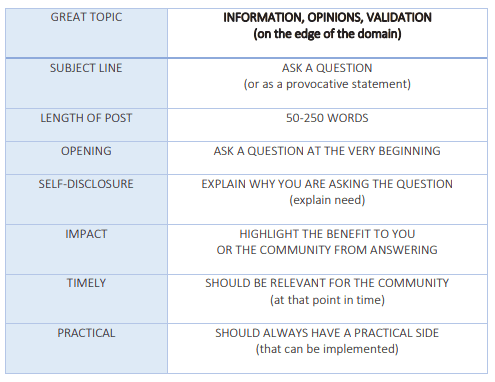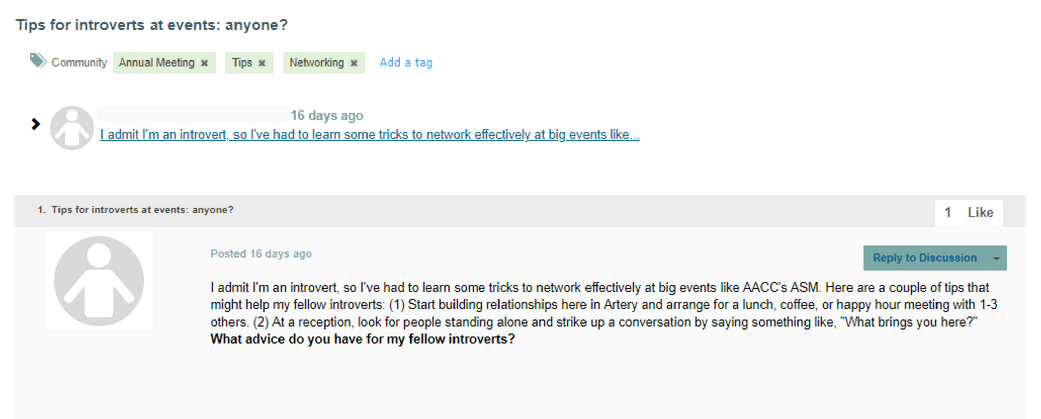
How to Create Engaging Online Discussions in Your Online Community
Create more engagement and increase member retention in your online community.
Often, and especially early on in the life of an online community, the community manager is the one who has to start discussions. If you’re a community manager, you know from experience that creating an engaging discussion is not easy. For example, asking someone what they think about an article and just putting the link out there is not typically enough.
Here are a few handy techniques you can use when creating a conversation to facilitate more interaction.
Applying a framework
In a training class I took with the World Bank Group, I was exposed to a framework to guide the creation of a discussion.
This framework is based on the theory that discussions build relationships and relationships build communities. Relationships develop through common interests and interacting and sharing your thoughts (self-disclosure) to create an emotional connection, i.e. a relationship.

Looking at some of the most successful conversations within your own community, you can identify the present or missing elements of the framework above.
I’ll walk you through the framework using an example from our community, the AACC Artery, below:

1. Put a question in the subject line.
In the above example, the user asks a direct question: “Tips for introverts at events: anyone?” Asking a question encourages members to click on the conversation in their activity feed online or in the daily email and prevents them from scrolling down and skipping it.
A subject line that stands out and sparks curiosity, appears natural, and isn’t too long goes a long way to grab people’s attention. When you think about your question, keep in mind that an open-ended question is more likely to produce the richest answers, compared to a yes-or-no question.
2. Watch out for length.
The 50-250 word guideline is valid both for questions we ask and answers we provide. People don’t read a question or a post that’s too long, especially online. We are distracted by a million other things and want to get to the juice right away. Keep this in mind when you craft your initial post, and give the reader what they need to know right away.
3. Engage immediately.
According to this framework, we need an engaging opening. Looking again at the above example, our user says: “I admit I’m an introvert, so I’ve had to learn some tricks to network effectively at big events.” She is getting to the point right away, telling us immediately what this conversation is about.
She knows that once people click on the subject line, she only has a minimal amount of time to engage them to respond.
The rule here is to open with a “call to action,” telling people exactly what we want them to do, and helping them decide quickly if they want to read the rest of the message or not.
4. Disclose your motivations.
Once our readers know that the message is for them, we can move on to self-disclosure. We want to use this part of the message to make it clear why we are asking the question, why it is relevant for us.
Our user, for example, does it in the opening itself, disclosing the fact that she is herself an introvert, and her motivation for this conversation is her sense of empathy for others but also her research to find new ways to get out of her shell.
The answers her colleagues would provide are as relevant for her as for others in her shoes. If you do the same and disclose the reasons why you are asking a question, people will be more likely to relate to you and respond.
5. Emphasize impact.
Any discussion can have an impact, such as finding a solution, changing an approach, or connecting people to each other. Highlighting a specific impact of responding to a post can increase the odds of someone stepping up and giving an answer.
In our user’s example, the impact is not clearly stated in the question, but is implied by suggesting that those tips will help her “fellow introverts” have a better experience at the meeting. She is implying that giving an answer would be relevant and helpful to anyone who might be introverted.
You could try to be more explicit than that by explaining why answers will help you or the community. Highlighting the impact of the conversation will increases the odds that someone will respond.
6. Be timely.
A question asked with no connection to the present would leave out another important part of the message: Why do we need to discuss this right now? Knowing that there is a certain urgency to the question we are asking or the topic we would like to discuss can prompt more answers.
In our user’s case, the discussion has been posted on a conference forum with the event fast approaching. She doesn’t need to say that it is timely because the event is happening in few weeks.
7. Be practical.
One mistake community managers make is to be too practical by focusing exclusively on encouraging problem-solving discussions. This practical focus, instead of a bonding and social-oriented focus, seems totally logical. In fact, most of the communities we develop, including mine, are centered on a high-level profession-specific information exchange, where members are looking to solve practical problems.
However, in my experience, bonding and validation discussions have proved to help people in the community in other ways.
Most first-time contributors in my community come in with validating or socially oriented discussions, where they simply want to exchange opinions or personal experiences.
These discussions are more easily approachable and are proven to make members feel more confident about the community, help them get to know each other better, and to trust each other more for when practical questions do need to be addressed.
So, for the discussions you create as a community manager, being practical should also mean being aware that bonding and social discussions also have a healthy function. If you do not have the subject matter expertise to guide discussions that are subject matter-related, you can always help your members bond in this way.
“The better people in your community know each other, the more they know and like each other. The more they like each other, the more they participate; the more they’re likely to respond to their requests for help; and, the more they’re likely to ask each other for help.” (Source: Building Community – A Primer)



